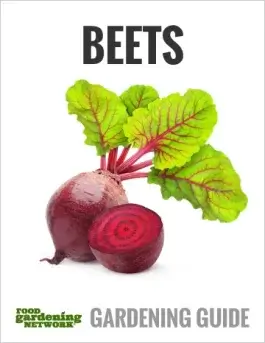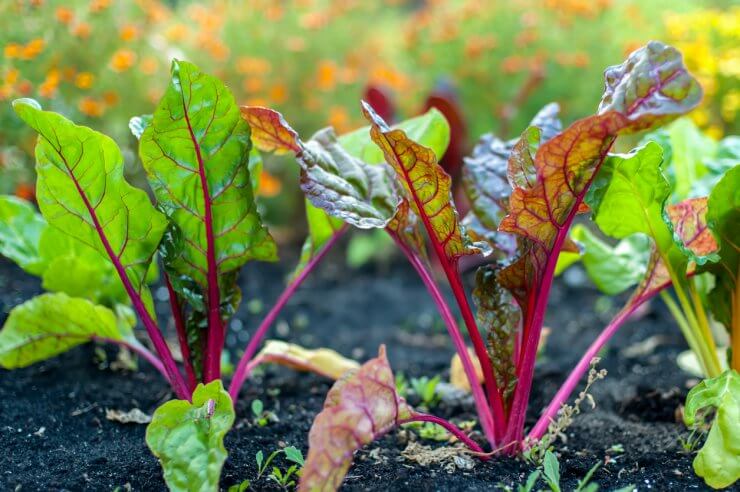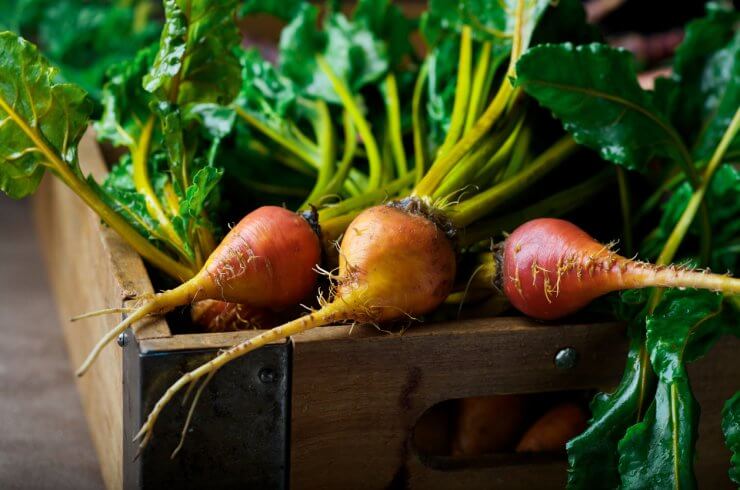
One of the many things I love about beets is the excuse they give me to grow some tasty beet companion plants. To be clear, I’m happy to have a garden full of beets just because I love beets. But like tomatoes, which offer a great excuse to plant more basil, beets and several other plants work especially well together.
Beets are relatively easy to grow, and they mature quickly. In addition, they’re a cool-weather crop, so you can get two or even three harvests throughout the year. And you can store beets for quite some time and in a variety of ways, from canning them to pickling them to “burying” them in a root cellar.

Beets need between 45 and 65 days to reach maturity. So if you want to increase your beet harvest, plant new seeds every 2-3 weeks for a month or so—but only in regions where the high temperature tops out at 75° F or less. Temperatures higher than that will cause your beet plants to bolt, rendering the roots too tough to eat and the leaves too bitter.
So what can you plant with them? And why?

7 Beet companion plants you’ll want in your garden
Companion planting matches plants with soil and nutrient needs that are different enough that they help, rather than hinder, the growth of both plants. Companion planting also helps add nutrients to the soil, reduce soil erosion, and shelter your beets from harsh weather and hot sun.
Good companion plants can help attract beneficial insects and deter pests, from tiny insects to hungry herbivorous mammals like rabbits and deer. You’ll still want to keep an eye out, however.
Pests on your beets, left unchecked, can damage and destroy your developing plants. Keeping a close watch on your plants during regular daily inspections will help you spot any pests before they can do irreparable harm. Healthy beets can bounce back from pest damage if you catch the pests quickly.
1. Brussels sprouts. Brussels sprouts, along with any other cruciferous vegetables, make great beet companion plants. Beets help enrich the soil, leading to fabulous broccoli, cabbage, and more.
2. Bush beans. Beets need plenty of sunshine, and pole beans can cast too much shade. Bush beans, however, add nitrogen and nutrients to the soil, while beets add minerals that the beans need.
3. Lettuce. Beets and lettuce grow well together since they both enjoy cooler weather. And while beetroots can grow deep into the soil, lettuce is a shallow-rooted vegetable, so the two don’t compete for resources.
4. Mint. Mint can be both a good and bad neighbor. It will grow in the worst of conditions, it attracts pollinators, and it repels aphids. However, mint will take over your entire garden if you aren’t careful.
5. Onions. Onions, along with other vegetables that have similarly pungent aromas, such as leeks and garlic, make good beet companion plants thanks to the fact that they repel several pests. Aphids, slugs, and even rabbits and deer tend to stay away from onions, meaning your beets may also be safe from these critters.
6. Radishes. Radishes are some of my favorite beet companion plants. For one thing, you can plant a radish seed in the ground and then enjoy radishes in your salad in three short weeks. As far as their compatibility with beets, however, the fast-growing radishes can help loosen the soil for the slightly slower-growing beets.
7. Swiss chard. This is a somewhat debatable choice. Swiss chard and beets are in the same family, so they have many of the same requirements around environmental preferences. They like cooler weather, plenty of sunshine, and moderately loose soil. So, yes, they do grow well together. The argument against growing these two close by is that they attract the same pests. And since you’re expanding the dinner table for those pests, there’s a greater chance they’ll find your garden and have an unwelcome party with your plants. You really could go either way here.
One trick I’ve learned about companion planting is that you don’t have to stick to what is written. For example, mint is one of the best beet companion plants because its strong scent helps deter pests that might otherwise destroy your beets. That means that almost any other strongly-scented herb will do the same. Basil, sage, and rosemary are all pretty good at keeping troublesome bugs at bay.
Want to learn more about this beautiful vegetable? With the Beautiful Beets premium gardening guide, you’ll have everything you need to know about growing and enjoying this versatile vegetable. Starting with the history and background of beets to hands-on advice on growing it … from planting techniques to watering (or not) … from easy-to-make, delicious recipes to the nutritional benefits of beets—get it all in the Beautiful Beets Gardening Guide right now!


 Previous
Previous


I live in zone7 in Reno, Nevada. I love beets and I learned so much from your short article about them. However, the mulching is easy with my vacuum/blower but, I’m not sure if leaves that come from a diseased tree that are now illegal to even plant, is the best thing to put in the soil! Everything grows well in the high temperatures whether I plant in Fall or Spring except for directly under this huge Dutch Elm tree.
What would you do ? I need your advice because all I’ve ever grown in the vegetable category are tomatoes and they were wonderful and delicious.
I certainly wouldn’t use the leaves as mulch from a known diseased tree, but if you use a mulch like straw/hay that will keep the leaves off the soil so that you can remove them when they fall. Depending on the size you could also prune off some branches to reduce leaf drop. Does the tree also drop seeds into your garden bed? I have a huge maple tree over my garden and it’s great for mulch, but I need to cover the garden until all the seeds have dropped in the spring or I’ll have a maple tree field! 🙂